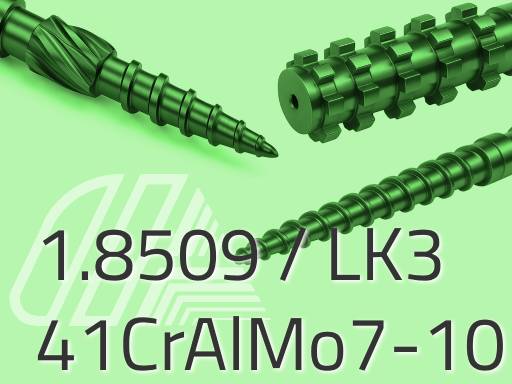41CrAlMo7-10 (1.8509)
EN 10085
Quenced Tempered Stabilized (+QT +SR)
PROPERTIES AND EMPLOYEMENTS
41CrAlMo7-10 steel, also known by the numerical designation 1.8509 (according to EN/DIN standards) and the trade name LK3, represents a high-performance chromium-aluminum-molybdenum alloy steel specifically designed for nitriding applications. It is classified as an alloy structural steel for nitriding, in accordance with international standards such as EN 10085. 1 This material is highly valued in various industries that require components subjected to extreme conditions, thanks to its unique combination of properties, which are particularly evident after specific heat treatments.

41CrAlMo7-10 steel is a versatile and robust material, whose excellent combination of surface wear resistance (after nitriding) and core toughness makes it indispensable in a wide range of industrial sectors. Its ability to withstand high loads, friction, and harsh environments positions it as a preferred choice for critical components.
General Industrial Applications
This steel is used in several key industries where durability and performance are paramount:
• Automotive Industry: Used for the production of critical components such as engine parts, transmission systems, and suspension components. Its strength ensures that parts can withstand the rigors of daily operation, contributing to the overall performance and safety of vehicles.
• Manufacturing Industry: Employed for the production of tools, dies, and jigs necessary for the production of other goods. Its hardness and wear resistance ensure that tools remain effective for extended periods, supporting efficiency in production lines. It is also used for industrial machinery components such as gears and shafts, contributing to the overall reliability and longevity of equipment.
• Mechanical Engineering and Machine Tools: Guarantees long service life, reliable functioning, and consistently high precision for machine tools, such as spindles, guide rails, grinding and drilling equipment, as well as milling machines and lathes.
• Oil and Gas Industry: Its ability to withstand extreme environments makes it ideal for use in pipelines, drilling rigs, and other offshore platforms. Its toughness and resistance to stress corrosion prevent catastrophic failures in these critical applications.
• Aerospace Industry: Used in the production of gears, shafts, and other small but critical components that must operate reliably under extreme conditions, where component failure is not permissible.
Specific Mechanical Components:
• Gears: Essential for power transmission, they require high surface wear resistance and good core toughness to withstand dynamic and pulsating loads.
• Shafts and Spindles: Rotating components that require high fatigue, torsional, and wear resistance. Examples include camshafts, crankshafts, grinding and milling spindles, automatic lathe spindles.
• Cylinders and Bushings: Require hard, wear-resistant surfaces to ensure smooth movement and long service life.
• Pump and Valve Components: Fuel pump parts for diesel engines, valve plates, valve stems, high-pressure valves, and valve parts in superheated steam operation (e.g., flanges).
• Molds and Tools: Used for plastic pressing molds, forming dies, cold extrusion tooling, punches and die inserts, gauges and fixtures, plastic molding components, press tooling, and forging dies.
• Engine Components: Pistons, connecting rods, piston rods, governors on steam turbines.
• Precision Screws and Worm Gears: Require high dimensional precision after heat treatment and high wear resistance.
• Extruder Components: Various wear-resistant parts on rubber and plastic extruders.
CORRESPONDENCE TO INTERNATIONAL DESIGNATIONS
| QUALITY | EUROPE | GERMANY | FRANCE | SPAIN | G.B. | USA | |
|---|---|---|---|---|---|---|---|
| EN | DIN | W.n. | AFNOR | UNE | B.S. | AISI/SAE | |
| 41CrAlMo7-10 (LK3) | 41CrAlMo7 | 41CrAlMo7 | 1.8509 | 40CAD6.12 | F1740 | 905M39 | ~K240065 |
CHEMICAL COMPOSITION % (EN 10085)
| STEEL DESIGNATION | CHEMICAL COMPOSITION | ||||||||||
|---|---|---|---|---|---|---|---|---|---|---|---|
| SYMBOLIC | NUMERIC | C | Si max | Mn | P max | S max | Al | Cr | Mo | Ni | V |
| 41CrAlMo7-10 | 1.8509 | 0,38 ÷ 0,45 | 0,40 | 0,40 ÷ 0,70 | 0,025 | 0,035 | 0,80 ÷ 1,20 | 1,50 ÷ 1,80 | 0,20 ÷ 0,35 | - | - |
CONCENTRATION LIMITS OF THE ELEMENTS THAT ARE NOT INDICATED IN THE TABLE CAN BE DEDUCED IN THE EN 10020 REGULATION.
MECHANICAL CHARACTERISTICS (EN 10085)
| STEEL | 16mm < d ≤ 40mm | 40mm < d ≤ 100mm | 100mm < d ≤ 160mm | 160mm < d ≤ 250mm | HV1 | |||||||||||||
| SYMBOLIC | NUMERIC | Re min | Rm | A min | KV min | Re min | Rm | A min | KV min | Re min | Rm | A min | KV min | Re min | Rm | A min | KV min | |
| N/mm2 | % | J | N/mm2 | % | J | N/mm2 | % | J | N/mm2 | % | J | |||||||
| 41CrAlMo7-10 | 1.8509 | 750 | 950 to 1150 |
11 | 25 | 720 | 900 to 1100 |
13 | 25 | 670 | 850 to 1050 |
14 | 30 | 625 | 800 to 1000 |
15 | 30 | 950 |
JOMINY HARDENABILITY (EN 10085)
| STEEL DESIGNATION | RANGE LIMITS | HRC HARDNESS MEASURED FROM THE QUENCHED END OF THE TEST TUBE (MM) | |||||||||||||
|---|---|---|---|---|---|---|---|---|---|---|---|---|---|---|---|
| SYMBOLIC | NUMERIC | 1,5 | 3 | 5 | 7 | 9 | 11 | 13 | 15 | 20 | 25 | 30 | 35 | 40 | |
| 41CrAlMo7-10 | 1.8509 | max | 60 | 60 | 59,5 | 59,5 | 59 | 59 | 58,5 | 58 | 57 | 56,5 | 55 | 53 | 51 |
| min | 53 | 52 | 51 | 50 | 49 | 48 | 47,5 | 47 | 44,5 | 41 | 39,5 | 37,5 | 36 | ||
USUALLY AVAILABLE EX STOCK
| M.T. COLORATION | QUALITY | HEAT TREATMENT | SURFACE | DIAMETER(mm) |
|---|---|---|---|---|
 |
41CrAlMo7-10 | Quenched and tempered (+QT) Quenched and tempered stabilized (+QT +SR) |
hot rolled peeled forged turned |
20-300 300-520 |






